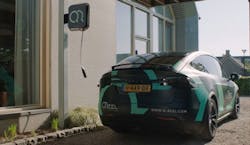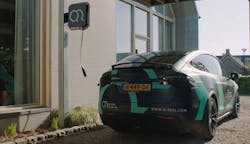Q-Reel Launches At-Home Semi-Automatic EV Charging Station
Post COVID-19, the global electric-vehicle and EV infrastructure market is projected to reach 4.18 million units by 2021 from an estimated 3.42 million units in 2020, at a CAGR of 22.1% (Source: MarketsandMarkets).
Because residential charging is convenient and inexpensive, most drivers of plug-in EVs do more than 80% of their charging at home, according to the U.S. Department of Energy (DoE). A problem for Level 1 or 2 EV supply equipment home charging, says DoE, is storing the charging cord securely so that it’s not damaged. DoE points out possible scenarios that may make the charging process risky, such as cables and cords suffering abuse like “being run over by a car.”
In the U.K., the consumer protection organization Electrical Safety First surveyed 1,500 EV owners in 2019 and found that 74% admit they have charged dangerously using domestic multi-socket extension leads, not suitable for outdoor use, to charge from the mains in their home. This is despite almost 9 out of 10 respondents admitting that they’re aware these extensions should not be used outside.
Why are EV owners creating a potentially hazardous situation? According to the study, a lack of public charging infrastructure for electric vehicles is forcing owners to charge dangerously.
For these reasons, despite everyone across the globe being heavily impacted by COVID-19, tech startup Q-Reel went ahead and launched an automated charging station for EVs on Kickstarter. It aims to free EV drivers from cable hassle in setting up home EV charging stations.
When done charging, Q-Reel’s patented release system automatically pushes the plug from the car. Plug removal can also be prompted through a mobile app. The automated ejection system disconnects the plug from the car inlet and automatically retracts the cable directly back to the charging station to prepare for the next charging session. On hookup the user simply grabs the plug and connects it to the vehicle charging port (Q-Reel is available with four common types of connector plugs). The cable retraction system is powered by a motor that correctly coordinates the belt-driven reeling movement and the connector’s anti-swing motion upon release from the vehicle.
Q-Reel’s retractable cables ensure that they will not suffer damage or abuse when not in use, while also protecting these parts from rain, humidity, and other external elements. A third-party safety-tested and -certified system serves as an appropriate power source, eliminating any reason to use the main home electricity source with or without extension cords/leads (or a daisy chain thereof)—especially those wires not suited for outside environments.
In addition, the flat cable inside the Q-Reel has enough cooling surface to prevent it from overheating, and it comes with a thermometer to regulate its temperature. A waterproof sealing protects the electronics compartment.
A mobile app (iOS and Android) lets users personalize charging-time preferences. In addition to optimizing the charge process, users can use the app interface to view live footage on a smartphone from Q-Reel’s built-in camera. The camera begins the smart-charging sequence as it detects the vehicle’s license plate. The smartphone app lets users set timers and determine when to unplug.
With every charge, the Q-Reel app provides an estimate of the added distance the EV or HEV can go. Home charging can use either Level 1 electric-vehicle supply equipment (EVSE) or Level 2 EVSE. Level 1 charging is accomplished through a 120-V ac plug. Level 1 adds about two to five miles of range to a vehicle per hour of charging time. Level 2 EVSE provides charging through a 240-V ac plug, adding about 10 to 60 miles of range to a vehicle per hour of charging time.
The Q-Reel charging station has a replaceable display that lights up in the dark for occasions when the driver arrives late or leaves early and needs to see what he/she is doing. The customizable display also offers personalization options, adding a house number, corporate logo, or any other design if desired.
An optional lightweight aluminum installation pole allows the Q-Reel charging station to be placed wherever the user wants. It consists of four segments that can be combined to a maximum height of three meters and with four meters of installation cable run-through from the bottom all the way up the pole where Q-Reel can be hung up out of the way. “In removing distinct obstacles around the often complicated and time-consuming traditional charging processes, we aim to help EV drivers everywhere charge their automobiles at their own home, without effort. Doing so will help lower the barrier-to-entry threshold, prompting more people to actually start driving electric." said Astrid Peters, CEO of Q-Reel, adding “Q-Reel intends to markedly stimulate widespread EV ownership and adaptation worldwide by easing and enhancing key home charger marketplace concerns relating to safety, usability and affordability.”

